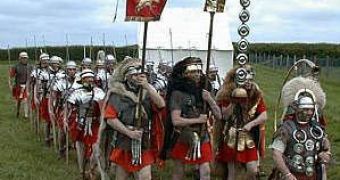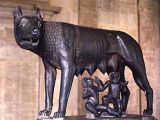1. The romans were the creators of the first large western empire, perfectly organized administratively, communicating through a network of roads and served by a powerful army united under the leadership of the emperor. The cohesion of all those territories was achieved by imposing the Latin language upon the conquered people, through the spread of an official religion and by maintaining a standing peace, pax romana, which allowed the development of trade and processing activities. First, the Romans would annex a new territory following military campaigns, then organize the new province inside the empire. Only a complex administrative machine, integrating heterogeneous people, allowed the existence of the empire for centuries.
2. The legend says that Rome was founded by two twins, Romulus and Remus, sons of the war god Mars and the vestal virgin Silvia Rhea. The city was founded on the place were the twins grew, first fed by a she-wolf, then cared by a family of shepherds made of Faustulus and his wife Acca Larentia. In time, this turned in the glitteriest city of the world, with giant official edifices, temples, palaces, theaters, circuses and so on. The Roman architecture was monumental, no matter if concerned utilitarian constructions, like roads, bridges or aqueducts, or decorative ones (arches of triumph or commemorative columns), far beyond the level of the neighboring people. The developed engineering played a huge role in the conquests of the empire.
3. Roman cities were perfectly planned and urbanized. They were rectangular (like the army's camps) and walled, having two main streets, cardo (cardus) and decumanus, which crossed in the center. In that place, a large square, called forum, was opened, and there the temples and public edifices were placed too. The forum was also a market and meeting place. All the streets and squares, at least in settlements of certain importance, were paved with paving stones. Houses were lined regularly on the both sides of the street, and had one or two levels. In the center of the dwelling, there was a square courtyard under which was located a cistern destined to collect rain water. The windows of the various dependencies of the house opened to the courtyard, almost never to the street.
4. More than supernatural, the Roman religion had an official character, the citizens being obliged by the law to practice it. The supreme priest was the emperor, regarded as a god, that's why offerings were made to him. The Roman polytheism absorbed not only the Greek gods, but also many gods taken from the conquered people. The family practiced the cult of manes (souls of the dead), lares and penates (the last two categories being house spirits), whose effigies were found in the atrium of the house. The religious ceremonies were ritual, but mostly formal. One specific cult act of the Romans was suovetaurilia: the sacrifice of a hog, a ram, and a bull. The animals were adorned with garlands to be immolated, and a professional butcher made the sacrifice over a stone altar, according with the legal prescriptions.
5. The powerful Roman army allowed the maintenance of such a large empire. Soldiers came from all social classes (except slaves) and the army offered the later possibility of a political career. The military service was very long and, depending on the soldier's origin and merits, various honors and ranks were offered. Individuals born in low classes were crowned as emperors with the help of the legions. That's why rulers always tried to repay the soldiers with all types of benefits, from land and house donations for the war veterans, to tax absolving.
6. The luxury products from all the empire flowed in Rome, and Roman ladies had fabrics, jewels, perfumes and cosmetics at their disposal. Patrician women excelled in elegance and snobbism. The most expensive flavors and spices came from the Near East. Roman women loved luxury parties and any showoff of power and richness. The corkscrew hairdo called "bee hive" spread amongst the second century Roman women.
7. In all Roman cities of certain importance, there were amphitheaters destined to the gladiator or animal fights. Many Christians were executed in these amphitheaters during the Christianity persecution in the first centuries AD. The Roman addiction for these bloody shows was so strong, that they were used as electoral propaganda for getting votes; those aspiring to public functions organized on their expense such games. The adage of any politician was panem et circenses (bread and circus). Roman enjoyed chariot races as well. The Roman chariot was two-wheeled and dragged by 4 horses.
8. Bread was a basic food and cereal trade was complex in the Roman Empire. Almost all the consumed wheat came from Egypt and North African provinces. Navis oneraria, capable of large cargoes, transported the wheat.
9. Each city has its market where trade was made, usually through barter. In recently conquered provinces, trade was a method of attracting the locals: local products were interchanged with products made in Rome, like fabrics, pottery, oil, wine, wheat and other agricultural products. Various cities were notorious for certain products.
10. Romans were great amateurs of fish. Off sea fishing boats were driven with large rectangular sails, while coastal fishing boats were driven by rows. Certain provinces were famous for their fish abundance, like Baetica (Spanish Andalusia) or Mauretania Tingitina (Morocco), close to Gibraltar. These regions were specialized in tuna and swordfish fishing, captured with special nets. Slated fish was exported to the whole empire. Romans also enjoyed garum, a sauce made of macerated fish, spicy and of intense flavor.
11. The emblem animal of the Roman Empire was the eagle. Its image was found from statues to painting, jewels, and carvings. The symbol of the Roman legions was a bronze eagle and that image was also found on public edifices, commemorative monuments, and adornments (fibulae, brooches and rings) and on the amulets worn by soldiers. The eagle emblem was later adopted by many barbarian people at the fall of the empire and, during the Middle Age, by many noble families. Another symbol of Rome was of course the she-wolf. The famous bronze-made Capitoline She-Wolf with the Twins statue dates from the 5th century BC.

 14 DAY TRIAL //
14 DAY TRIAL // 
